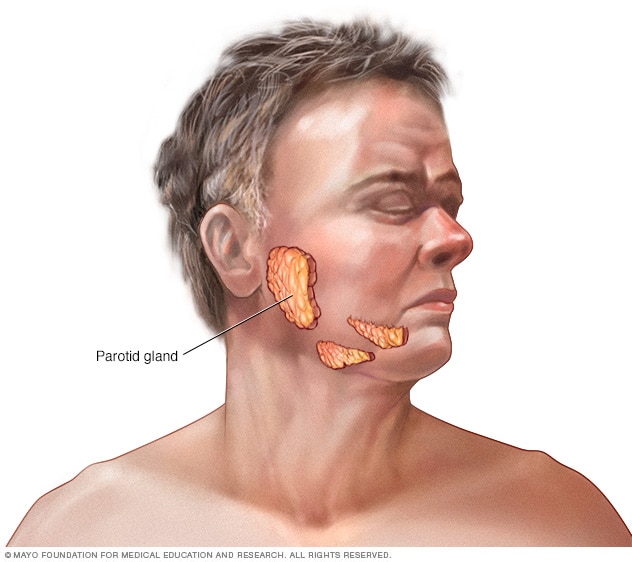Salivary gland tumors
Salivary gland tumors
Parotid tumors
Parotid glands

Parotid glands
The parotid glands are a set of three pairs of large salivary glands. Each set of glands has its own tube (duct) that leads from the gland to the mouth.
Parotid tumors are abnormal growths of cells (tumors) that form in the parotid glands. The parotid glands are two salivary glands located on each side of the face, just in front of the ears. Salivary glands produce saliva to help chew and digest food.
There are many salivary glands in the lips, cheeks, mouth and throat. Tumors can occur in any of these glands, but the parotid glands are the most common location for salivary gland tumors. Most parotid gland tumors are benign (benign), although some tumors can become cancerous.
Parotid tumors often cause swelling of the face or jaw that is usually not painful. Other symptoms include numbness, burning or tingling of the face, or a loss of facial movement.
Parotid tumor treatment usually involves surgery to remove the tumor. If the tumor contains cancer cells, additional treatments may be recommended.
diagnosis
Tests and procedures to diagnose a parotid tumor may include:
- Eine körperliche Untersuchung. Ihr Arzt wird Ihren Kiefer, Hals und Rachen auf Knoten oder Schwellungen abtasten.
-
Taking a tissue sample for testing (biopsy).Your doctor may recommend a needle biopsy procedure, such as: B. a fine needle aspiration or a core needle biopsy to remove a tissue sample for testing. During a needle biopsy, the doctor inserts a thin needle through your skin and into the affected parotid gland. The needle is used to take a sample of cells or fluid.
In the laboratory, doctors can determine what types of cells are involved and whether they are cancerous. Your doctor uses this information to determine your prognosis and the most appropriate treatments for you.
- Bildgebende Tests. Ihr Arzt kann bildgebende Untersuchungen Ihrer Ohrspeicheldrüse empfehlen, um die Größe Ihres Tumors zu verstehen. Wenn Ihr Parotistumor krebsartig ist, müssen Sie möglicherweise Tests durchführen, um nach Anzeichen dafür zu suchen, dass sich der Krebs ausgebreitet hat. Tests können Ultraschall, MRT und CT umfassen.
Treatment
Treatment for parotid tumors usually involves surgery to remove the tumor. If the tumor contains cancer cells, your doctor may recommend additional treatments such as radiation therapy and chemotherapy.
surgery
Operations to remove parotid tumors include:
- Entfernung eines Teils der Ohrspeicheldrüse. Bei den meisten Parotistumoren können Chirurgen den Tumor und einen Teil des gesunden Parotisgewebes um ihn herum herausschneiden (oberflächliche Parotidektomie).
- Entfernung der gesamten Ohrspeicheldrüse. Eine Operation zur Entfernung der gesamten Ohrspeicheldrüse (totale Parotidektomie) kann bei größeren Tumoren und solchen, die die tieferen Teile der Ohrspeicheldrüse betreffen, empfohlen werden.
- Umfangreichere Operationen bei größeren Krebsarten. Wenn Ohrspeicheldrüsenkrebs in nahe gelegene Knochen und Muskeln eingewachsen ist, kann eine umfangreichere Operation erforderlich sein. Chirurgen versuchen, den gesamten Krebs und eine kleine Menge des ihn umgebenden gesunden Gewebes zu entfernen. Dann arbeiten sie daran, den Bereich zu reparieren, damit Sie weiter kauen, schlucken, sprechen, atmen und Ihr Gesicht bewegen können. Dies kann die Übertragung von Haut, Gewebe, Knochen oder Nerven von anderen Teilen Ihres Körpers zur Durchführung von Reparaturen beinhalten.
To access the parotid gland, surgeons make an incision near the ear. During surgery, special care is taken not to damage surrounding structures such as the facial nerve, which runs through the parotid gland. The facial nerve controls facial movement, so stretching or cutting the nerve can result in partial or complete paralysis of the face, which can be temporary or permanent.
If the facial nerve needs to be cut to remove the entire tumor, surgeons can repair it using nerves from other areas of your body or processed nerve grafts from donors.
radiotherapy
Radiation therapy uses powerful beams of energy such as X-rays, protons or neutrons to kill cancer cells. If your parotid tumor is cancerous, radiation therapy may be recommended after surgery to kill any remaining cancer cells. Radiation therapy is sometimes used as an initial treatment when surgery is not possible.
chemotherapy
Chemotherapy is a drug treatment that uses drugs to kill cancer cells. It is not routinely used to treat parotid tumors. But sometimes it is combined with radiation therapy to treat parotid cancer that has a high risk of spreading or cancer that cannot be completely removed with surgery. Chemotherapy could also be an option for people with advanced parotid cancer that has spread to other parts of the body.
Sources:
- Flint PW, et al. Cummings HNO-Heilkunde: Kopf- und Halschirurgie. 6. Aufl. Saunders Elsevier; 2015. https://www.clinicalkey.com. Zugriff am 30. April 2020.
- Smith Wohnmobil. Parotidektomie. https://www.uptodate.com/contents/search. Zugriff am 30. April 2020.
- Kopf-Hals-Krebs. Nationales umfassendes Krebsnetzwerk. https://www.nccn.org/professionals/physician_gls/default.aspx. Zugriff am 30. April 2020.

 Suche
Suche
 Mein Konto
Mein Konto